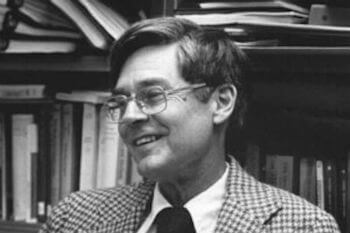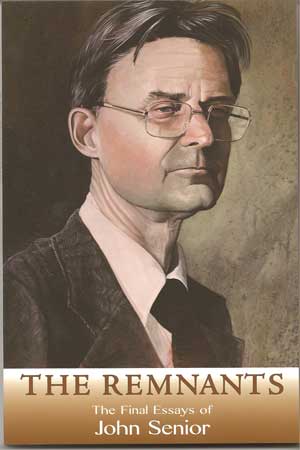Once I had embarked safe and sound on the ship of the Church, I was dismayed to see it headed straight towards the shipwreck that I had just escaped. A worldly Church and a world without the Church on the edge of the abyss.
Thus wrote the author and philosopher John Senior shortly before his death in 1999. Although his work continues to inspire small pockets of Catholics today, Senior is a prophetic figure who deserves to be far more widely known, both for his philosophy of liberal education and for his principled traditionalism.
Early Life
Born in Connecticut in 1923, John Senior grew up in a cultured and multi-talented East-coast family, but with little organized religion. He was deeply interested in literature, poetry, and music but was not an overly bookish boy—he loved swimming, bicycling, and anything related to cowboys. During the depression of the 1930s, the Senior family fell on hard times; the financial strain, as well as dismay at seeing the encroaching urbanization of Long Island (where his family was living at the time) inspired thirteen-year-old John Senior to run away from home and head west, in search of his beloved cowboys. Boarding a Greyhound bus, John’s money took him as far as the Dakotas, where he found manual work with a Norwegian immigrant named Tinzer. Tinzer eventually informed John’s parents of his whereabouts, but the upshot of the escapade was that the Seniors consented to John’s “going west” every summer thereafter to work. Senior eventually did find work with real cowboys, which included everything from drinking coffee round the campfire to going on multi-week cattle drives.
Academically, Senior was successful in high school. World War II interrupted his college education, but following honorable discharge from the military (he was never deployed), Senior enrolled at Columbia University, where he would eventually earn his doctorate. He focused on literature and philosophy, and came under the influential mentorship of the great liberal arts promoter Mark Van Doren, who also profoundly affected the course of Thomas Merton’s intellectual life. In 1945, Senior married Priscilla Woods, whom he had met during his first years of college before joining the army. Their union would be blessed with three children.
From Positivism to Common Sense
In an interview published in the French newspaper La Nef towards the close of his life—“The Final Interview”, as it is titled in The Remnants, a posthumously published collection of Senior’s writings—Senior succinctly explained many of the key elements in his life and thought. He described his intellectual journey as one from “Positivism and Agnosticism” to the Catholic Church. Dabbling in Eastern philosophy, Marx, and Freud, Senior’s encounter with such thinkers as Plato and Thomas Aquinas convinced him of the existence of truth and common sense, and confronted him with traditional Western Christianity. This would eventually lead him and his wife, along with their children, into the Roman Catholic Church in 1960. (He had already converted to Christianity earlier in the 1950s).
The whole complexus of Western religion, culture, and thought with which his study of Christianity brought him into contact had a profound influence on his pedagogical goals as a professor at the English department of Cornell University, which he joined in 1955. “As a young professor and convert [to Christianity] in the 1950s, I realized that the scholastic philosophical system, so effective in refuting the rational skepticism of my generation, had had no impact on students whose minds were disconnected from tangible and emotional realities.” At Cornell, Senior found himself “in one of the top ten American universities, led by an intellectual elite that had been perverted by Existentialism and Phenomenology.” Thus Senior took up a position at the University of Kansas, “fleeing,” as he put it, “to the American West, where people’s minds were not as corrupted.” There, with two colleagues, Dennis Quinn and Frank Nellick, he founded the innovatively traditional program which has since become inseparably linked to Senior’s name: the Integrated Humanities Program (IHP).
Humanities and Christian Culture
Seeing that modern students were out of touch with reality due to the technological and philosophically nonsensical age in which they lived, Senior tried to teach the “perennial philosophy” of the fact that “reality is real” by indirect means—“forcing myself to rectify our student’s imaginations by teaching the poetry of Homer and Virgil, Saint Augustine’s Confessions,” and other great works of the Western tradition. He believed that materialism along with subjectivism had divorced modern man so far from the reality of creation that the arguments of thinkers like Aristotle, Augustine, or Aquinas were initially ineffective in communicating truth since they were based on a completely different conception of reality and truth. The only way to make such authors accessible was to reconnect men with reality through experiential or “poetic” knowledge rather than purely intellectual knowledge. Texts like Homer’s Iliad or Shakespeare’s dramas, which were not so much discursive and logical as poetic and emotive, along with activities like dancing, classical and folk music, star-gazing, and calligraphy had the potential to refresh and reform the students’ imaginations by putting them in touch with the real. Consequently, Senior and his colleagues Quinn and Nellick incorporated such “poetic” activities as part of their humanities program. This fundamental and important concept of “the real” was central to Senior’s low-tech educational method.
Senior developed and expounded this diagnostic of modern “anti-realism” along with a presentation of the remedies found in traditional humanities in two famous books, The Death of Christian Culture and The Restoration of Christian Culture. “There is something destructive—destructive of the human itself—in cutting us off from the earth from whence we came and the stars, the angels, and God himself to whom we go,” Senior wrote in The Restoration. In the attempt to help students regain touch with the really real, Senior found that the experience of wonder was fundamental. For Senior, the mind had to be born in wonder if it was to be brought to wisdom, and this was only possible through experiencing God’s creation “raw.”
Poor little rich suburban children who have all these delights [of modern conveniences], and living in constant fluorescent glare, have never seen the stars, which St Thomas, following Aristotle and all the ancients, says are the first begetters of that primary experience of reality formulated as the first of all principles in metaphysics: that something is.
Senior saw the pre-Socratic Heraclitus as the fore-father of the fundamental “modernist” error: that since everything is in flux “there is no such thing as river, no such thing as a thing” (from “The Last Epistle,” in The Remnants collection.)
“Not only did IHP boys get their hair cut [this was the 70s after all] and girls start wearing skirts, but the students were also turning to Christ,” Fr. Bethel writes in his excellent biography John Senior and the Restoration of Realism. The success of Senior’s educational model was quickly verified by numerous converts to Catholicism among his students, even though he did not actively proselytize. This, and along with it the fact that his students started becoming proponents of objective truth, brought the ire of the University of Kansas down upon the IHP. The University squashed the program in the mid-seventies. Senior continued teaching his humanities courses until he retired from KU in 1984.
His Spirituality
Senior had a great love of the Benedictine monastic tradition: a number of his students in the IHP later entered monasteries. The IHP students used to visit Fontgombault Abbey in France, for example, in order to enter into the round of chanted prayer, the axis around which Europe had turned for so many centuries. “Everything that I have learned in literature and philosophy can be summed up by ora et labora. Reading the Rule during a retreat in a Benedictine house (before the Council and its disasters) was a decisive element in my conversion,” Senior wrote. Some of his students had a fundamental role in the foundation of Clear Creek Abbey in Oklahoma: the current superior of that monastery, Abbot Anderson, was a student of Senior’s, as was Bishop James Conley of Lincoln, Nebraska, and Archbishop Paul Coakley of Oklahoma City.
The Vatican II Controversy
Senior was keenly aware of the crisis in the Church following Vatican II and was highly critical of the direction the Church had taken in its “updating.” A lover of the Church’s literary and artistic traditions as well as of her rigorous theology and intellectual tradition, the widespread apostasy from beauty and truth in the post-conciliar Church grieved Senior deeply. Given his path to the Faith and his intellectual assessment of modernity, it is therefore unsurprising that he was a staunch supporter of the traditional Latin Mass and found refuge with the Society of St. Pius X for many years. He is buried in St Mary’s, Kansas.
The status of the SSPX, especially after the episcopal consecrations in 1988, weighed on Senior heavily. His view of their position changed over the years, gradually becoming more favorable towards them. His essay “The Glass Confessional” in The Remnants is a poignant exposé of the soul-searching he undertook in trying to follow the path that seemed most faithful and obedient.
Speaking in his “Final Interview” of the liturgical crisis of the Church, and the motu proprio Ecclesia Dei of John Paul II in particular, Senior stated in piercing and profound words that there is no “new Mass,” only “a multitude of deviations” from the Mass:
It is true that in a pragmatic and imperfect world, we must be aware that we can still remain devoted to prayer—the only thing necessary (unum necessarium)—of which the primary act is the Mass. The negative aspect of Ecclesia Dei is that it insinuates that permission is needed to exercise a right. What is called the “Tridentine Mass” is simply what Christ instituted on the Cross. One cannot “prefer” the old Mass to the new one, because there is no “new” Mass, but a multitude of deviations, some of which border on blasphemy.
In the intuition that there is no need for permission to “exercise a right” to pray the Mass of the Ages, we hear an early echo of arguments in defense of the Latin Mass that would later find a more theologically complete articulation on the lips of Joseph Ratzinger and would return again in a worldwide chorus upon the release of the motu proprio Traditionis Custodes in 2021.
Senior seems to combine a unique blend of pessimism and hope, especially in regard to the Church. In the “Final Interview,” he told La Nef: “The crisis is over; we have lost. This is no longer just a prediction, it is a simple observation: Rome has been desecrated. We are in the age of darkness. Triumphalist reactions are in vain.” But Senior did not despair: “The fear of the Lord is not despair,” he continued. “Quite the contrary. Insofar as it is in the first degree of humility [in the Rule of Saint Benedict], it is also our second reason to hope… after Our Lady, Mother of Good Hope.” In one sense, this dark outlook has been somewhat disproved by the exponential development of the traditionalist movement in the years after Senior’s death. At the same time, the current pontificate and its renewed clampdown has more than confirmed it.
Although I have only been able to briefly touch on Senior’s insights in this article, his thought deserves consideration by all serious Catholics, especially as his predictions and insights prove to be ever more true and urgent as the world and the Church continue to suffer from the cancer of modernism. In the coming months I will be drawing on Senior and his followers to investigate various subjects in greater detail. As a prophet both of Tradition and realism, Senior, in his own way, ought to have a place alongside the first generation of traditionalist heroes such as Malachi Martin, Michael Davies, and Fr. Bryan Houghton.



